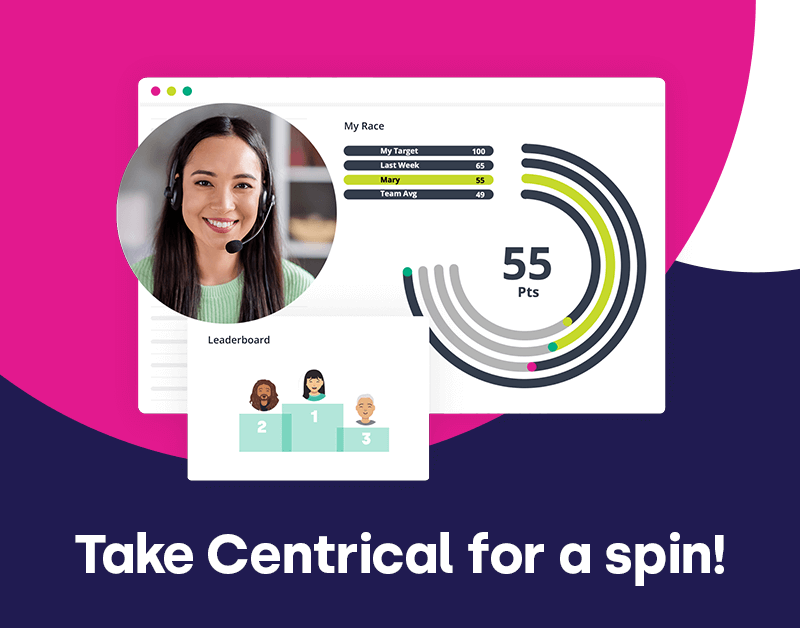This article was originally published by Brandon Hall Group.
As AI reshapes the customer service industry, businesses face a critical challenge: how to systematically prepare their frontline employees for evolving roles while maintaining operational excellence. The traditional approach of periodic training sessions and generic skill assessments no longer suffices when customer expectations and technological capabilities change rapidly.
Recent research from Brandon Hall Group™ reveals that 64% of Learning & Development leaders identify closing skill gaps as their top priority, yet many organizations struggle to implement effective, scalable solutions. The key lies in leveraging AI-powered platforms that can:
- Identify skill gaps in real-time.
- Deliver targeted microlearning experiences.
- Track progress with precision.
Centrical is pioneering this approach, helping organizations transform their customer service capabilities through intelligent skill development systems.
The most successful organizations are moving to proactive, AI-driven skill development that anticipates future needs while addressing current performance gaps. This shift requires a fundamental rethinking of how businesses approach employee development, measurement and continuous improvement in customer-facing roles.
The Strategic Imperative for Systematic Skill Gap Analysis
Modern customer service environments demand a sophisticated approach to identifying and addressing skill gaps. The most effective approaches begin with comprehensive data collection from multiple sources: customer feedback, interaction recordings, performance metrics, and peer observations. AI algorithms can process this information to identify patterns that managers might miss, such as subtle communication deficiencies or knowledge gaps that emerge during specific types of customer interactions.
Organizations that excel in this area analyze how employees:
- Apply knowledge in real-world scenarios.
- Adapt to new situations.
- Collaborate effectively with AI tools.
This depth of analysis enables targeted interventions that address root causes rather than symptoms.
A Skills Hub developed by MetLife, a Brandon Hall Group™ Excellence Award Winner, exemplifies this approach. By consolidating training opportunities and using AI to analyze associate needs, MetLife empowered over 7,000 customer service associates with personalized development paths. The system analyzed performance data to identify specific skill gaps and delivered targeted content that resulted in 19,000+ hours of training consumption within the first year.
Delivering Targeted Microlearning at Scale
Once skill gaps are identified, the delivery mechanism becomes crucial. Microlearning has emerged as the preferred method for customer service training because it aligns with the fast-paced nature of these roles and the need for just-in-time knowledge acquisition.
Effective microlearning programs deliver content in digestible formats that can be consumed during brief breaks or integrated into the workflow. The most successful implementations use AI to determine optimal timing, content sequencing, and delivery methods based on individual learning patterns and performance data.
The key lies in its relevance and timing. AI systems can analyze employee performance and behavioral data from customer interactions, quality monitoring and customer surveys, identifying challenges and proactively delivering targeted content that prepares employees for specific scenarios. This approach transforms learning from a separate activity into an integrated part of the work experience.
Organizations should focus on creating learning experiences that are immediately applicable to real-world scenarios. Rather than broad, general training modules, successful programs deliver specific skills and knowledge that employees can apply within hours or days of completion, also through innovative tools like simulation-based training. This immediate relevance increases engagement and retention while demonstrating clear value to both employees and managers.
Tracking Progress and Measuring Impact
The ability to track progress and measure impact distinguishes successful AI-driven skill development programs from traditional training approaches. Advanced analytics provide insights into learning effectiveness, skill acquisition rates, and the correlation between training activities and business outcomes.
Effective measurement systems track multiple dimensions of progress:
- Knowledge acquisition.
- Skill application.
- Behavioral change.
- Business impact.
AI systems can correlate training activities with performance improvements, customer satisfaction scores, and other key metrics to demonstrate clear return on investment.
The most sophisticated tracking systems provide real-time feedback to both employees and managers. Employees can see their progress toward specific goals, while managers receive insights into team-wide skill development trends and areas requiring additional focus. This transparency creates accountability and enables rapid course corrections when programs aren’t delivering the expected results.
Organizations using Centrical’s platform have demonstrated the power of comprehensive tracking by showing clear correlations between targeted skill development and improved customer satisfaction scores. The ability to measure impact at both individual and organizational levels enables continuous program refinement and optimization.
Preparing for AI-Augmented Customer Service Roles
The integration of AI into customer service operations requires a fundamental shift in how organizations think about employee roles and required competencies. Rather than replacing human agents, AI tools are augmenting their capabilities, enabling them to handle more complex interactions and provide higher-value services.
Successful preparation for AI-augmented roles focuses on developing skills that complement artificial intelligence rather than compete with it. These include emotional intelligence, complex problem-solving, creative thinking, and the ability to work effectively with AI tools. Organizations must help employees understand how to leverage AI capabilities while maintaining the human touch that customers value.
The transition requires ongoing support and skill development. Employees need training, not just on new tools and processes, but on:
- How to interpret AI-generated insights.
- When to override AI recommendations.
- How to maintain authentic human connections in increasingly automated environments.
Building a Culture of Continuous Learning
Technology alone cannot drive successful transformation. Organizations must foster a culture that values continuous learning and skill development. This requires leadership commitment, clear communication about the benefits of AI-augmented roles, and recognition systems that reward learning and adaptation to create better habits.
Successful organizations create learning communities where employees share experiences, collaborate on problem-solving, and support each other’s development. AI systems can facilitate these connections by identifying employees with complementary skills and suggesting collaboration opportunities.
The most effective programs also provide clear career pathways that demonstrate how skill development leads to advancement opportunities. When employees see direct connections between learning activities and career growth, engagement and participation increase significantly.
Best Practices
Organizations embarking on AI-driven skill development should start with a skills gap analysis to establish baseline capabilities and identify priority areas. This should involve multiple stakeholders, including employees, managers, and customers, to ensure a complete picture of the current state and future needs.
Successful implementations integrate skill development into existing workflows rather than creating separate training programs. This integration reduces friction and increases adoption while ensuring that learning activities directly support business objectives.
Continuous monitoring and adjustment are essential for long-term success. Organizations should:
- Regularly assess program effectiveness.
- Gather feedback from participants.
- Refine approaches based on results.
The flexibility to adapt quickly to changing needs and technologies is crucial for maintaining program relevance and impact.
As AI continues to reshape customer service, organizations that invest in skill development will create sustainable competitive advantages. By leveraging AI-powered platforms to identify gaps, deliver targeted learning and track progress, companies can build customer service teams that excel in an AI-augmented world while maintaining the human connections that drive customer loyalty and business success.
Get insights sent to your inbox
Engage and motivate your frontline teams
Improve performance with an AI-powered digital coach
Deliver world class CX with dynamic, actionable quality evaluations
Boost performance with personalized, actionable goals
Nurture employee success with the power of AI
Listen and respond to your frontline, continuously
Drive productivity with performance-driven learning that sticks
Drive agent efficiency, deliver client results
Keep tech teams motivated and proficient on products and services while exceeding targets
Maintain compliance while building customer happiness and loyalty
Enlighten energy teams to boost engagement
Engage, develop, and retain your agents while driving better CX
Improve the employee experience for your reservations and service desk agents







 Madeleine Freind
Madeleine Freind
 Natalie Roth
Natalie Roth Linat Mart
Linat Mart












 Doron Neumann
Doron Neumann Gal Rimon
Gal Rimon Daphne Saragosti
Daphne Saragosti Ella Davidson
Ella Davidson Ariel Herman
Ariel Herman Ronen Botzer
Ronen Botzer